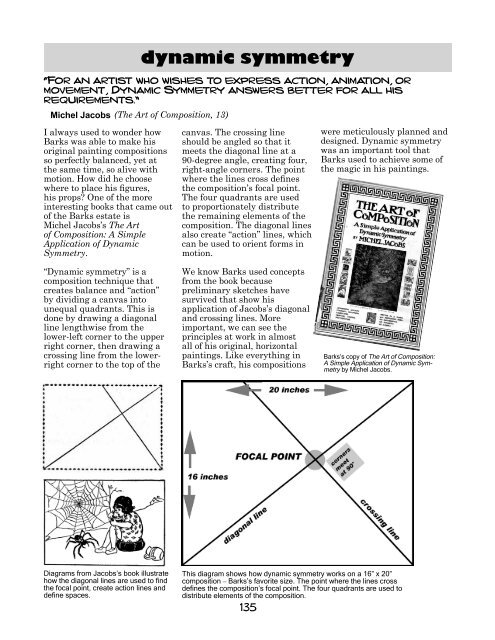Painting Fine-Art Cartoons in Oils - Enchanted Images
Painting Fine-Art Cartoons in Oils - Enchanted Images
Painting Fine-Art Cartoons in Oils - Enchanted Images
You also want an ePaper? Increase the reach of your titles
YUMPU automatically turns print PDFs into web optimized ePapers that Google loves.
I always used to wonder how<br />
Barks was able to make his<br />
orig<strong>in</strong>al pa<strong>in</strong>t<strong>in</strong>g compositions<br />
so perfectly balanced, yet at<br />
the same time, so alive with<br />
motion. How did he choose<br />
where to place his figures,<br />
his props? One of the more<br />
<strong>in</strong>terest<strong>in</strong>g books that came out<br />
of the Barks estate is<br />
Michel Jacobs’s The <strong>Art</strong><br />
of Composition: A Simple<br />
Application of Dynamic<br />
Symmetry.<br />
“Dynamic symmetry” is a<br />
composition technique that<br />
creates balance and “action”<br />
by divid<strong>in</strong>g a canvas <strong>in</strong>to<br />
unequal quadrants. This is<br />
done by draw<strong>in</strong>g a diagonal<br />
l<strong>in</strong>e lengthwise from the<br />
lower-left corner to the upper<br />
right corner, then draw<strong>in</strong>g a<br />
cross<strong>in</strong>g l<strong>in</strong>e from the lowerright<br />
corner to the top of the<br />
dynamic symmetry<br />
“For an artist who wishes to express action, animation, or<br />
movement, Dynamic Symmetry answers better for all his<br />
requirements.”<br />
Michel Jacobs (The <strong>Art</strong> of Composition, 13)<br />
Diagrams from Jacobs’s book illustrate<br />
how the diagonal l<strong>in</strong>es are used to f<strong>in</strong>d<br />
the focal po<strong>in</strong>t, create action l<strong>in</strong>es and<br />
def<strong>in</strong>e spaces.<br />
canvas. The cross<strong>in</strong>g l<strong>in</strong>e<br />
should be angled so that it<br />
meets the diagonal l<strong>in</strong>e at a<br />
90-degree angle, creat<strong>in</strong>g four,<br />
right-angle corners. The po<strong>in</strong>t<br />
where the l<strong>in</strong>es cross def<strong>in</strong>es<br />
the composition’s focal po<strong>in</strong>t.<br />
The four quadrants are used<br />
to proportionately distribute<br />
the rema<strong>in</strong><strong>in</strong>g elements of the<br />
composition. The diagonal l<strong>in</strong>es<br />
also create “action” l<strong>in</strong>es, which<br />
can be used to orient forms <strong>in</strong><br />
motion.<br />
We know Barks used concepts<br />
from the book because<br />
prelim<strong>in</strong>ary sketches have<br />
survived that show his<br />
application of Jacobs’s diagonal<br />
and cross<strong>in</strong>g l<strong>in</strong>es. More<br />
important, we can see the<br />
pr<strong>in</strong>ciples at work <strong>in</strong> almost<br />
all of his orig<strong>in</strong>al, horizontal<br />
pa<strong>in</strong>t<strong>in</strong>gs. Like everyth<strong>in</strong>g <strong>in</strong><br />
Barks’s craft, his compositions<br />
135<br />
were meticulously planned and<br />
designed. Dynamic symmetry<br />
was an important tool that<br />
Barks used to achieve some of<br />
the magic <strong>in</strong> his pa<strong>in</strong>t<strong>in</strong>gs.<br />
Barks’s copy of The <strong>Art</strong> of Composition:<br />
A Simple Application of Dynamic Symmetry<br />
by Michel Jacobs.<br />
This diagram shows how dynamic symmetry works on a 16” x 20”<br />
composition – Barks’s favorite size. The po<strong>in</strong>t where the l<strong>in</strong>es cross<br />
def<strong>in</strong>es the composition’s focal po<strong>in</strong>t. The four quadrants are used to<br />
distribute elements of the composition.


